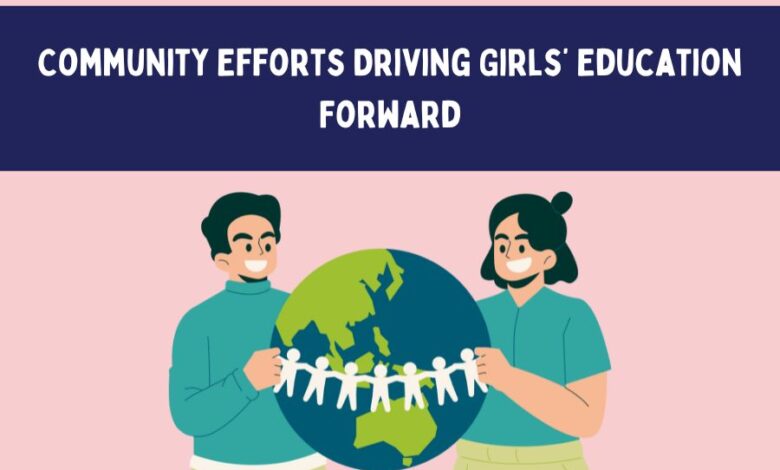Community Efforts Driving Girls’ Education Forward

Access to quality education is a cornerstone of societal progress. Yet, millions of children, particularly girls, continue to face barriers in their educational journey. While India has made commendable strides in literacy and school enrolment, significant challenges remain in making education truly inclusive and equitable—especially for girls from marginalized communities.
This blog explores the structural, cultural, and economic challenges that hinder access to education for girls and outlines initiatives that are working toward meaningful change.
The Gender Gap in Indian Education: Where Do We Stand?
A Snapshot of the Numbers
Despite increased awareness and policy efforts, India still faces a significant gender gap in educational outcomes. According to the Unified District Information System for Education Plus (UDISE+), while enrolment in primary education is relatively balanced, dropout rates spike for girls as they transition into secondary and higher secondary levels.
| Level of Education | Gross Enrolment Ratio (Girls) | Dropout Rate (Girls) |
|---|---|---|
| Primary | 102.4% | 1.2% |
| Upper Primary | 90.1% | 3.6% |
| Secondary | 79.4% | 17.0% |
| Higher Secondary | 59.2% | 23.5% |
These numbers highlight that while initial access is improving, retention and completion still remain significant challenges, especially in rural areas and economically weaker sections.
Barriers Beyond the Classroom
Cultural Norms and Early Marriages
In many parts of India, traditional beliefs around gender roles continue to impede the education for girls in India. Education is often deprioritized in favor of early marriage or household responsibilities. These societal pressures force girls to drop out prematurely, especially during adolescence.
Inadequate Infrastructure
Lack of gender-sensitive infrastructure in schools—like separate toilets for girls—contributes to absenteeism and dropouts. The onset of menstruation becomes a critical turning point when many girls leave school altogether due to shame or lack of proper facilities.
Safety Concerns
In both urban slums and rural areas, concerns about the safety of girls traveling to school lead families to limit or discontinue their daughters’ education. Distance to the nearest secondary school often becomes a deciding factor in whether a girl continues her studies.
Governmental and Policy Interventions
Schemes and Initiatives
India has launched several programs to address these challenges:
- Beti Bachao Beti Padhao (BBBP): Focused on awareness and empowerment, especially in districts with low gender development indices.
- Kasturba Gandhi Balika Vidyalaya (KGBV): Residential schools for girls from disadvantaged groups.
- National Scheme of Incentive to Girls for Secondary Education (NSIGSE): Offers financial incentives to delay early marriage and encourage secondary education.
Progress Made
These efforts have had measurable impact:
- Increased enrolment in government schools
- Improved literacy rates among women in younger age groups
- Community engagement and local advocacy around girls’ education
However, policy alone cannot resolve deep-rooted societal issues. This is where local organizations and community-driven efforts play a crucial role.
Role of NGOs in Bridging the Gap
Community-Centric Education Models
Non-Governmental Organizations (NGOs) are filling the critical gaps where government infrastructure falls short. By focusing on outreach, mentorship, and on-ground support, NGOs provide not just educational resources but a holistic support system for girls.
One such Free education NGO in Delhi NCR has been instrumental in transforming the lives of underprivileged girls through tailored learning modules, after-school programs, and life-skill development initiatives. These programs go beyond textbooks, addressing emotional well-being, health education, and career readiness.
Why NGO-Led Models Work
- Localized Approach: NGOs often employ teachers and facilitators from the same communities, creating trust and relatability.
- Flexible Learning: Alternate schooling methods and bridge courses help re-integrate dropouts.
- Parental Engagement: NGOs work directly with families to change mindsets around education.
Read Also>>> Viral oval diamond rings on Instagram At Krk Jewels
Breaking the Cycle: Long-Term Solutions
Importance of Female Educators
Studies show that having female teachers increases enrolment and retention of girl students. Female educators serve as role models and create a safer, more welcoming environment in schools.
Digital Learning for the Last Mile
With the rise of mobile and internet penetration, EdTech has become a powerful tool for remote education. Low-cost tablets, mobile apps, and online classrooms are being increasingly adopted to reach girls who cannot attend school due to social or geographical barriers.
Advantages of Digital Learning
- Accessibility: Enables education from home.
- Affordability: Cost-effective compared to physical infrastructure.
- Customization: Personalized learning pace helps weaker students catch up.
What Can Be Done Next?
Policy Recommendations
- Make menstrual hygiene a part of school infrastructure and curriculum.
- Strengthen public-private partnerships to expand the reach of educational initiatives.
- Mandate safety audits and female-friendly transport services in rural zones.
Community-Driven Change
- Awareness Drives: Use local leaders to champion the cause.
- Peer Mentoring: Encourage senior students to guide and inspire younger girls.
- Parental Counseling: Regular workshops to break cultural stigmas around girls’ education.
Conclusion
Ensuring that every girl in India has the opportunity to complete her education isn’t just a moral imperative—it’s essential for the country’s social and economic growth. From government schemes to the tireless work of NGOs, progress is being made, but there’s still a long road ahead.
We must continue to build environments that support, protect, and inspire girls to learn, grow, and lead.
FAQs
Q1. What are the main challenges girls face in accessing education in India?
A1. Major challenges include cultural beliefs, early marriage, lack of school infrastructure, safety concerns, and economic hardship.
Q2. How are NGOs helping improve girls’ education in India?
A2. NGOs focus on community engagement, mentorship, flexible learning models, and direct family support to ensure girls stay in school.
Q3. Are there any government schemes specifically for girls’ education?
A3. Yes, programs like Beti Bachao Beti Padhao, KGBV, and NSIGSE specifically aim to promote and support girls’ education.
Q4. How can digital technology help girls continue their education?
A4. Digital platforms offer flexible, accessible, and personalized learning experiences, especially for girls in remote or socially restricted settings.
Q5. What can individuals do to support girls’ education in India?
A5. Volunteering, donating to trustworthy NGOs, spreading awareness, and mentoring young girls are powerful ways to contribute.



